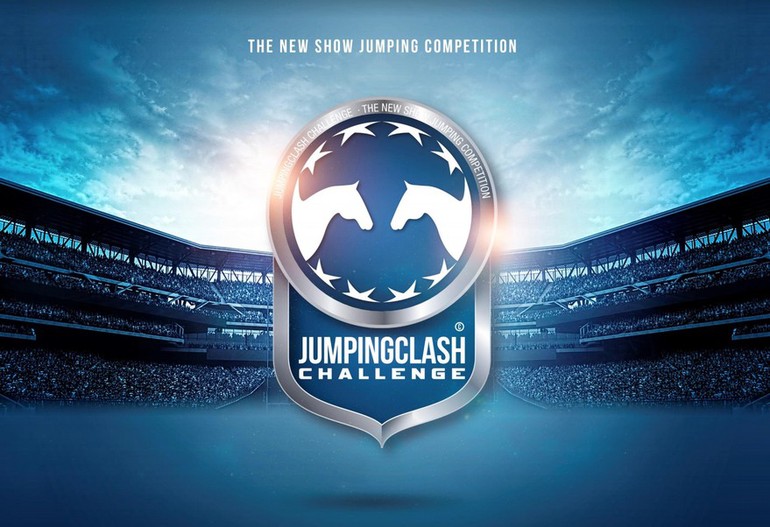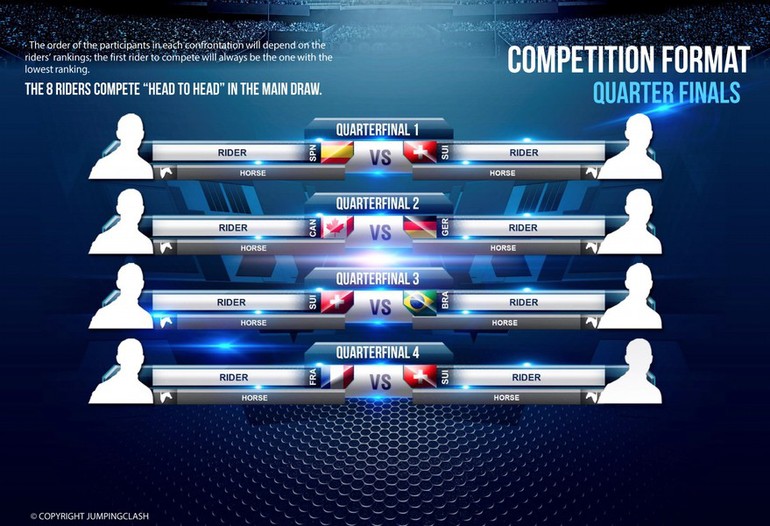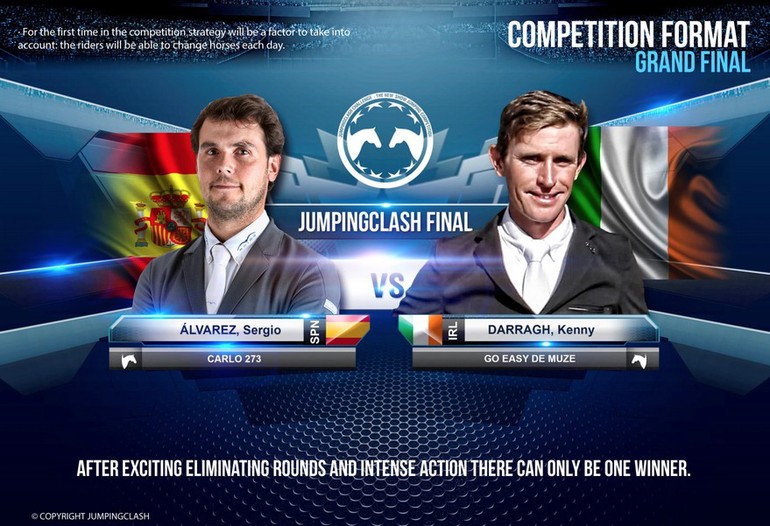They were a little disappointed with the sport they love. So, they came up with a concept totally different – an innovative way of presenting jumping aimed at a much wider audience. World of Showjumping spoke with Daniel Entrecanales, President & Founder of the JumpingClash Challenge, as well as the CEO and Founder Pablo Márquez – as the two have just about a month to go until their brand new concept world premiers during Madrid Horse Week.
The idea of the JumpingClash Challenge was born in 2011. Well, at least that is when the company was founded by Entrecanales and Márquez. The two men had a vision: A competition that would display the sport of jumping at its very best, with focus on the action and emotion in it.
Entrecanales and Márquez were driven forward by a small dissatisfaction with the sport they both love: “We have so many different concepts in the jumping sport – the Championships, the Nations Cup-series, the World Cup-series and the Global Tour-series, yet is seems like it is always the same approach that is taken. It is a first round, perhaps a second round and a jump-off.”
“With this format, it is hard to own the timing of the competition. An example is that you never know how many riders there will be in the jump-off, and hence how long it will take – it can be fifteen and it can be three. This makes it difficult to present our sport on television, and to have any kind of production around it.”
This is according to Entrecanales and Márquez the key to get more jumping on television: “The sport needs to own its timing. And, jumping just hasn’t. We wanted to change that.”
There were some aspects of equestrianism in general, that Entrecanales and Márquez thought would work to their advantage when the time would come to introduce the JumpingClash Challenge. “Equestrianism has a great advantage; it is in some form present in every country in the world. This is a very important element in our sport,” Entrecanales and Márquez points towards when speaking about how they visualize the sport of jumping to reach wider. “However, the sport of jumping has some problems. It is complicated to follow for a non-equestrian-audience, and it is hard to present on television – especially because of the lack of ownership in regards to the timing.”
Entrecanales and Márquez were thinking long and hard about how to make a product to fit for television without changing the essence of the jumping sport. From 2011 to 2013 they developed their ideas, until they in September 2013 presented their concept JumpingClash Challenge for FEI that would have to approve the new system. “We have a concept that is simple to understand, and that is attractive for the viewer,” Entrecanales and Márquez point out. “The key elements in this regard is that there is one loser and one winner after each round of jumping. It is one against the other; for the general public this is much easier to understand than having fifty riders go around and then a jump-off. It also creates a more dynamic competition.”
The JumpingClash Challenge is indeed something different; a fresh breath of air. It is based on a series of encounters between the riders, and each of these will have a winner – hence the name JumpingClash.
There will be three days of competition in the JumpingClash Challenge; and the first part will be a classifying round.
As the JumpingClash Challenge presents two groups of riders – a group of seeded riders competing against a group of challenger riders – the classifying round will be used to determine which riders at the show will go into the group of the challenger riders.
The eight best riders present at the show based on the FEI ranking will go into the group for the seeded riders, and the eight best riders from the first classifying round – open to the rest of the competitors – go into the group of the challenger riders.
When the action gets underway, it all starts up with sixteen horse-and-rider combinations challenging each other in a total of eight encounters. Which seeded rider will compete against which challenger rider will be determined by a draw.
In the first round of the JumpingClash Challenge, the riders will compete in the form of confrontations, coming out to the course individually, one after the other. The winner of each confrontation will classify for quarter-final, while the loser is out of the competition.
The final of the JumpingClash Challenge will take place on the penultimate day of the event. The eight best riders from the encounters in round one are eligible for the final, and will again start up with meeting each other one against one in encounters. The class will over two different rounds against the clock, with one jump-off.
The winner of each of the first four encounters move on to the quarter final, where the winner of each encounter will go into a jump-off against each other.
“Setting the riders up against each other in encounters – one against one – creates a loser and a winner, and is much more simple for the general public to follow. With the presentation on television that will go with it, we will also easily be able to create heroes out of the horses and riders. Presentation wise we are much closer to a sport like boxing than riding, so it is easier to follow for those not familiar with the jumping sport,” Entrecanales and Márquez explain. “The riders can also change the horse for each day of competition. This is of course necessary to protect the welfare of the horse, but can also create opportunities to use tactics against opponents.”
“The structure of the final also allows us to have time for the production, with previews and interviews – in addition to what goes on in the ring. We want to present sportcasts and themed sections, and not only the competition itself. The themed section will focus on the horses and the riders. This will give the general public a chance to get to know them, outside the ring – creating emotion. With only twelve rounds and two jump-off rounds in the final, we actually have the time for the production. This means we can present the riders, horses as well as their teams and sponsors in a proper way. We want to create a TV product that is attractive to watch, also for those that do not know the sport.”
Another important part that has not slipped the attention of Entrecanales and Márquez, is the graphics. “This will also be much closer to other sports than we are used to; we have looked towards formula one, tennis, boxing and football for ideas on how to present out sport in a better way. Looking forwards, we also hope to be able to use the graphics for branding – for example for the horse owners.”
And with a team consisting of Ismael Peña – Head of Mediapro's Formula 1 project and Responsible of the Mediapro Group in Brazil, Pilar Jimenez – Business Development Mediapro International, Pep Rúbies – Executive Director Special Projects, Marisa Luisa Jimenez – Director Content Division and R&D, Ignacio Negreiro – Content Division and R&D, Daniel Lozano – Director Broadcast Division as well as Víctor Tárraga – TV Graphics Software Developer WTVISION, it looks like the JumpingClash Challenge is set to become a television hit.
“We think we have an incredible product in our hands,” Entrecanales and Márquez confess.
To make the JumpingClash Challenge even more different, Entrecanales and Márquez want to introduce a special space dedicated to the riders and their sponsors during and in between the encounters – currently it’s nick-named ‘The Quarter-Final Paddock’. This area can also potentially be used for high visibility branding, making the JumpingClash Challenge attractive for sponsors. “We also have a special ring jacket for the riders we would like to introduce, but this has not been approved yet,” the two reveal.
So no wonder, the two have big ambitions. “We want to go global, and introduce our concept at international 3*, 4* and 5* events in the States, the Middle East and Europe. In 2017 we hope to see the JumpingClash Challenge at three to four events. Unlike other series, we will have a full year program – and go live both indoors and outdoors.”
And what’s in it for the riders? “Well, world ranking points and good prize money – at a five-star event a JumpingClash Challenge must offer a minimum of totally 200 000 Euro in prize money. Every single rider in the JumpingClash Challenge quarter final, semi-final and final rounds will receive win money. If you go all the way, there is a lot of jumping – and we want to award the riders for that. Secondly, with the method we are using of ‘eliminating’ the rider with the worst score of the two in an encounter we have to keep them motivated to keep going – and this is what our win-money-chart will do. If the first rider in an encounter is clear, and the second rider has one down – he or she should still keep moving against the clock to get as far as possible up on the overall ranking of the class,” Entrecanales and Márquez detail. “It should not all be for nothing when a rider goes in the ring. In the first round of encounters, that count sixteen riders – twelve will receive prize money. From the quarter final and onwards to the big final, prize money is distributed to all riders.”
For those that are curious, there will be a chance to watch the world premiere of the JumpingClash Challenge during Madrid Horse Week in November with the classifying round on Thursday 24th of November, the first round of encounters on Friday 25th and the final on Saturday 26th. “This way, we also leave space for any Grand Prix at any venue – we do not want to take over anything, we want the JumpingClash Challenge to be an exciting addition,” Entrecanales and Márquez explain.
Text © World of Showjumping // Pictures and video © JumpingClash











